| |
Improved outcomes in patients with hepatitis C with difficult-to-treat characteristics: Randomized study of higher doses of peginterferon a-2a and ribavirin
|
| |
| |
Hepatology Oct 2008
Michael W. Fried 1 *, Donald M. Jensen 2, Maribel Rodriguez-Torres 3, Lisa M. Nyberg 4, Adrian M. Di Bisceglie 5, Timothy R. Morgan 6, Paul J. Pockros 7, Amy Lin 8, Lisa Cupelli 8, Frank Duff 8, Ka Wang 8, David R. Nelson 9
1University of North Carolina, Chapel Hill, NC
2University of Chicago Chicago IL
3Fundacion de Investigacion De Diego Santurce Puerto Rico
4Kaiser Permanente Medical Center San Diego CA
5St. Louis University St. Louis MO
6Veterans Affairs Medical Center Long Beach CA
7Scripps Clinic La Jolla CA
8Roche Nutley NJ
9University of Florida Gainesville FL
Funded by:
F. Hoffmann-La Roche
National Institutes of Health; Grant Number: GCRC RR 00046, K24 DK066144
"An additional 0.3 log10 reduction in viral load was seen as early as hour 72 for the higher dose compared to the lower dose of peginterferon alfa-2a, at either dose of ribavirin."........"Results of multiple logistic regression models showed initial viral declines had a significant impact on SVR and that peginterferon dose effect on SVR is reflected through the effect of initial viral declines on SVR. When baseline factors and assigned peginterferon and ribavirin doses were examined, patients with larger alanine aminotransferase quotient (relative to upper limit of normal) and higher ribavirin dose that achieved end-of-treatment viral response had a trend toward a lower probability of relapse (P = 0.03 and 0.06, respectively)."...."Steady-state concentrations of peginterferon alfa-2a were reached after week 8. The mean serum trough concentration at steady state, as indicated by pooled data collected at weeks 12 and 24, was approximately 1.5-fold higher in groups receiving peginterferon alfa-2a at 270 ug/week (groups C and D) than at 180 ug/week (groups A and B), which suggests a linear dose-exposure relationship over the dose range (Table 2)."
Abstract
Treatment response remains suboptimal for many patients with chronic hepatitis C, particularly those with genotype 1 and high levels of viremia. The efficacy of high-dose regimens of peginterferon alfa-2a and ribavirin was compared with conventional dose regimens in patients with features predicting poor treatment responses. Eligible treatment-naive adults with genotype 1 infection, hepatitis C virus (HCV) RNA >800,000 IU/mL and body weight >85 kg were randomized to double-blind treatment with peginterferon alfa-2a at 180 or 270 ug/week plus ribavirin at 1200 or 1600 mg/day for 48 weeks (four regimens were evaluated). The primary endpoint was viral kinetics during the first 24 weeks of therapy. Among patients receiving peginterferon alfa-2a (270 ug/week) the magnitude of HCV RNA reduction was significantly greater than for patients randomized to the conventional dose of peginterferon alfa-2a (180 ug/week) for the pairwise comparison for ribavirin at 1600 mg/day (P = 0.036) and numerically greater for the pairwise comparison for ribavirin at 1200 mg/day (P = 0.060). Patients randomized to the highest doses of peginterferon alfa-2a (270 ug/week) and ribavirin (1600 mg/day) experienced the numerically highest rates of sustained virologic response (HCV RNA < 50 IU/mL) and the lowest relapse rate (47% and 19%, respectively). The arm with the higher doses of both drugs was less well-tolerated than the other regimens. Conclusion: Higher fixed doses of peginterferon alfa-2a (270 ug/week) and ribavirin (1600 mg/day) may increase sustained virologic response rates compared with lower doses of both drugs in patients with a cluster of difficult-to-treat characteristics.
Therapy of chronic hepatitis C with peginterferon and ribavirin yields an overall sustained virologic response (SVR) rate between 54%-56%.[1-3] Numerous virologic and host factors have been identified that have a substantial impact on the likelihood of achieving an SVR. Genotype 1 and baseline levels of hepatitis C virus (HCV) RNA above 800,000 IU/mL are the strongest factors associated with diminished response rates.[1-3] Among host characteristics, the presence of cirrhosis, African American race, obesity, insulin resistance, and hepatic steatosis have also been demonstrated to decrease the rate of SVR.[1][2][4-8]
The observation that increased body weight diminishes antiviral response, regardless of peginterferon preparation, is under active investigation but is likely complex and multifactorial.[1][2][9] Obesity, a surrogate marker for hepatic steatosis, has been associated with decreased antiviral efficacy as well as increased risk of fibrosis, whereas hepatic steatosis is also frequently associated with insulin resistance that impairs antiviral and immune-stimulating properties of peginterferon-alfa.[5][10-12] A recent retrospective analysis of patients from VIRAHEP-C, a study comparing response rates between African Americans and Caucasian Americans, suggested that insulin resistance, rather than steatosis, was implicated in lower rates of SVR.[8]
Individual patients with chronic hepatitis C represent a blend of multiple attributes that can affect antiviral response. Thus, a patient with genotype 1 infection may also have high levels of viremia and be overweight, a combination of factors whose pretreatment probability of response has been shown to be lower than any single unfavorable predictive factor.[13] Indeed, a recent retrospective study suggests that these poor prognostic factors tend to cluster together, defining a population of patients who are least likely to respond to conventional antiviral therapy with peginterferon and ribavirin.[14]
Numerous strategies have been suggested to improve the SVR rates for patients predicted to be poorly responsive to interferon-based therapies. Increasing the dose of peginterferon, increasing the dose of ribavirin, and prolonging the duration of therapy have all met with limited success.[15-18] However, no prospective study to date has focused solely on a patient population with an aggregation of multiple unfavorable characteristics. The aim of this study, therefore, was to compare the impact on viral kinetics and SVR of treatment regimens using higher doses of peginterferon alfa-2a and ribavirin against lower dose, conventional regimens in patients with a cluster of poor prognostic factors (genotype 1, high baseline levels of HCV RNA, and body weight >85 kg). The pharmacokinetics of peginterferon and ribavirin in heavier patients was also explored.
Results
Patient Demographic Characteristics.
Enrollment began in January 2004 and the study ended in February 2006. A total of 301 patients were screened and 188 patients were randomly assigned to treatment. A total of 133 patients (71%) completed 48 weeks of treatment and end-of-follow-up data are available for 143 (76%) patients (Fig. 1). This reflects that individuals who were not responding to therapy at the time of premature treatment discontinuation were not required to return for prolonged posttreatment follow-up. Baseline characteristics of patients across the four treatment groups were similar (Table 1). Typical patients enrolled in the trial were clinically obese as evidenced by the mean body mass index, which was well above 30 kg/m2 in each treatment group.
Efficacy
Viral Kinetics.
Numerically greater reductions in HCV RNA levels were seen in patients treated with the higher dose (270 ug/week, groups C and D) than with the lower dose (180 ug/week, groups A and B) of peginterferon alfa-2a (40KD) during the first 24 weeks of treatment (Fig. 2). Among patients receiving the same dose of peginterferon alfa-2a in groups A and B (180 g/week) and in groups C and D (270 ug/week), the higher ribavirin dose (1600 mg/day) had no apparent impact on the reduction in HCV RNA level compared with the lower ribavirin dose of 1200 mg/day (Fig. 2; group A versus group B, P = 0.756, and group C versus group D, P = 0.922). An additional 0.3 log10 reduction in viral load was seen as early as hour 72 for the higher dose compared to the lower dose of peginterferon alfa-2a, at either dose of ribavirin. Afterward, the rate of viral decline appeared to be similar. Among patients receiving peginterferon alfa-2a (270 ug/week) the magnitude of HCV RNA reduction was significantly greater than for patients randomized to the conventional dose of peginterferon alfa-2a (180 ug/week) for the pairwise comparison for ribavirin at 1600 mg/day (group B versus group D, P = 0.036) and numerically greater for the pairwise comparison for ribavirin at 1200 mg/day (group A versus C, P = 0.060).
Figure 2. Mean change in HCV RNA level during the first 24 weeks of treatment. Among patients receiving the higher and lower doses of peginterferon alfa-2a: P = 0.036 for those receiving the higher dose of ribavirin (1600 mg/day, group B versus group D) and P = 0.061 for those receiving the standard dose of ribavirin (1200 mg/day, group A versus group C).
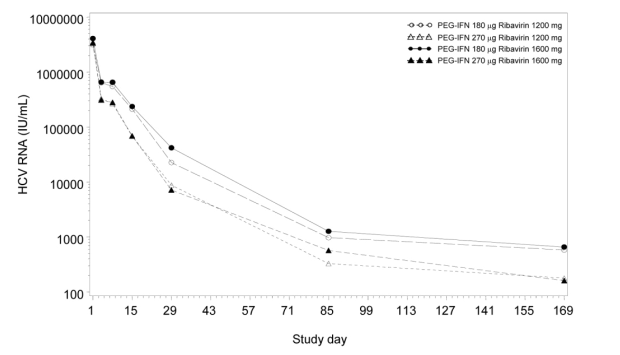
Virologic Response.
The proportion of patients with a rapid virologic response (RVR), defined as undetectable HCV RNA (<50 IU/mL) at week 4, increased according to the intensity of treatment (Fig. 3). In groups A, B, C, and D, 2.2% (95% confidence interval [CI] 0%-6.4%), 8.5% (95% CI 0.5%-16.5%), 10.6% (95% CI 1.8%-19.5%), and 12.8% (95% CI 3.2%-22.3%) of patients, respectively, achieved an RVR. In contrast, the proportion of patients with undetectable HCV RNA at week 12 was generally similar across groups (Fig. 3). A null response (<1-log decrease HCV RNA by week 12) was seen in 13%, 6%, 4%, and 13% (for groups A, B, C, and D, respectively). The highest rate of virologic response (<50 IU/mL) at week 24 was obtained in patients treated with the highest doses of both peginterferon alfa-2a and ribavirin (group D; 68.1% [95% CI 54.8%-81.4%]; Fig. 3), whereas the rates of virologic response were somewhat lower and similar in groups A (56.5% [95% CI 42.2%-70.9%]), B (55.3% [95% CI 41.1%-69.5%]), and C (59.6% [95% CI 45.5%-73.6%]). At the end of treatment, virologic response rates (<50 IU/mL) were very similar in groups B, C, and D, all of which were approximately 10% greater than that in group A (Fig. 3).
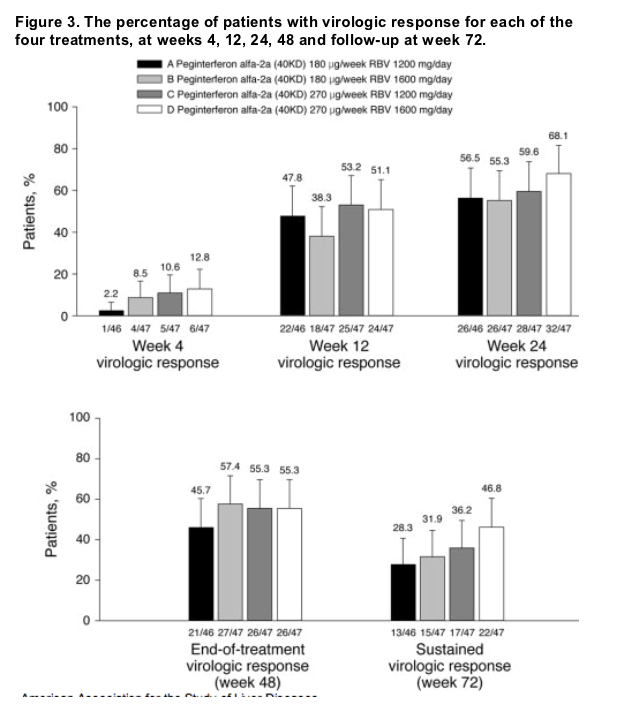
At the end of follow-up, patients treated with peginterferon alfa-2a at 270 ug/week plus ribavirin at 1600 mg/day (group D) had the highest SVR rate (46.8% [95% CI 32.5%-61.1%]; Fig. 3) and patients in group A had the lowest SVR rate (28.3% [95% CI 15.3%-41.3%]; Fig. 3) (P = 0.09, group A versus group D). Results of multiple logistic regression models showed initial viral declines had a significant impact on SVR and that peginterferon dose effect on SVR is reflected through the effect of initial viral declines on SVR. When baseline factors and assigned peginterferon and ribavirin doses were examined, patients with larger alanine aminotransferase quotient (relative to upper limit of normal) and higher ribavirin dose that achieved end-of-treatment viral response had a trend toward a lower probability of relapse (P = 0.03 and 0.06, respectively).
The differences between end-of-treatment and end-of-follow-up virologic responses were partially attributable to differences in the rate of relapse, which decreased according to the intensity of the treatment regimen. Among groups A, B, and C, respectively, the relapse rates between week 48 and week 72 were 40% (8/20), 42% (11/26), and 46% (12/26). In comparison, the relapse rate in the highest dose arm (group D) was only 19% (5/26) (P < 0.0001, group A versus group D).
Pharmacokinetics
Although the pharmacokinetics of peginterferon alfa-2a up to doses of 360 ug/week has been shown to be dose-proportional in nonobese patients little is known about the pharmacokinetics and dose-proportionality of peginterferon alfa-2a and ribavirin in heavier patients included in the current study.[19] A total of 76 patients participated in the pharmacokinetic evaluation.
Peginterferon alfa-2a.
Steady-state concentrations of peginterferon alfa-2a were reached after week 8. The mean serum trough concentration at steady state, as indicated by pooled data collected at weeks 12 and 24, was approximately 1.5-fold higher in groups receiving peginterferon alfa-2a at 270 ug/week (groups C and D) than at 180 ug/week (groups A and B), which suggests a linear dose-exposure relationship over the dose range (Table 2). A small number of patients had very low peginterferon alfa-2a serum exposure levels throughout the study, irrespective of the received dose or their body weight. This phenomenon has been previously observed in other studies, though the cause is presently unknown. These outliers were present in all datasets and were evenly distributed to all the treatment groups in very small numbers. The data variations (percent coefficient of variation of 34%-48%) were at the lower end of previous observed range (45%-55% in general).
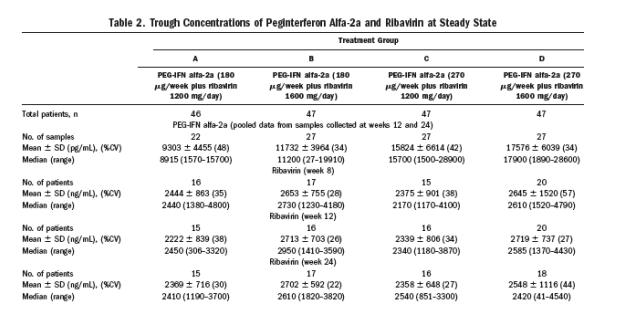
Ribavirin.
Steady-state concentrations of ribavirin were reached at week 8, with similar exposure observed at weeks 12 and 24 (data not shown). Ribavirin exposure was higher in patients receiving 1600 mg/day (groups B and D) than 1200 mg/day (groups A and C; Table 2). However, dose modifications were more common in the high-dose groups (four to five patients per group at week 24, 24%-31%) than in group A (two patients at week 24, 13%). As a consequence, mean ribavirin plasma trough concentrations in groups B and D increased in a less-than-dose-proportional manner (Table 2). The data variations (percent coefficient of variation) were in an acceptable range of 28%-57%.
Safety.
The adverse event profile was similar to that previously reported in patients treated with the combination of peginterferon alfa-2a plus ribavirin (Table 3). The frequency of serious adverse events was generally similar across the four treatment groups, as was the frequency of individual adverse events (Table 3). A total of five (11%), one (2%), seven (15%), and nine (19%) patients in groups A, B, C, and D, respectively, withdrew from treatment prematurely because of an adverse event or intercurrent illness. The incidence of depression was generally similar across the three treatment groups (Table 3), as was the incidence of severe depression (three, one, zero, and two patients, respectively, in groups A, B, C, and D). Only one patient withdrew from treatment prematurely because of depression-related events (group A).
The frequency of dose reductions for adverse events or laboratory abnormalities varied with the intensity of the treatment regimen (Table 4). A total of 2%-4% of patients in all groups withdrew from treatment prematurely because of laboratory abnormalities (Fig. 1). Grade 3 or 4 neutropenia (0.5 to <7.5 cells _ 109/L) was most common in group D with the highest dose of both peginterferon and ribavirin (13%, 15%, 9%, and 23%, respectively, for groups A, B, C, and D). Grade 3 thrombocytopenia (20 to <50 cells _ 109/L) was reported in 2%, 9%, 6%, and 2% of patients in groups A, B, C, and D, respectively. A total of nine (20%), 16 (34%), 11 (23%), and 13 (28%) patients in groups A, B, C, and D, respectively, had hemoglobin concentrations <10 g/dL at some time during the study. Overall, one (2%), three (6%), one (2%), and five (11%) patients in groups A, B, C, and D, respectively, received epoetin to treat anemia, and one patient in group D who received epoetin also received filgrastim to treat neutropenia.
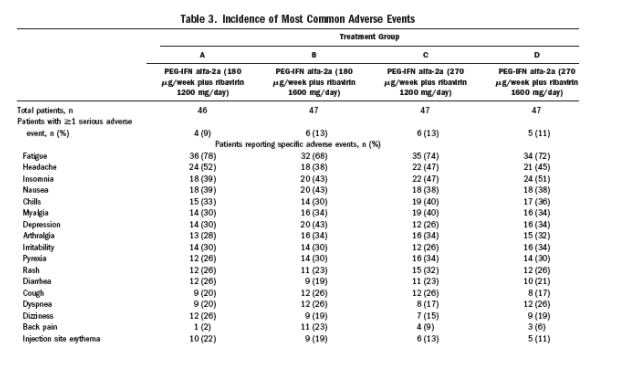
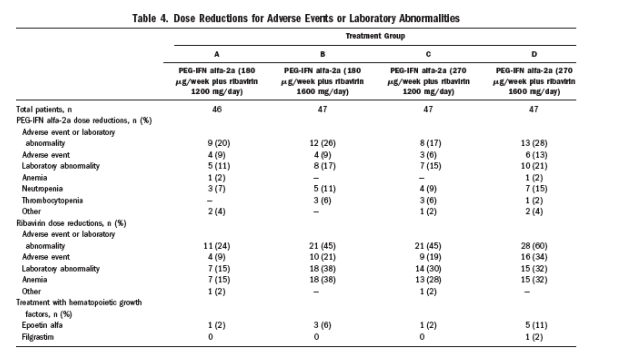
Discussion
The response to peginterferon and ribavirin, while effective for the majority of patients, is neither universal nor guaranteed and is highly related to multiple virologic and host factors. Although it is expected that newer classes of drugs, such as protease and polymerase inhibitors, will improve sustained response rates for all individuals, these agents remain investigational.[20] Furthermore, it has become apparent that peginterferon and ribavirin will serve as the backbone of triple drug regimens for the foreseeable future.[21][22] Therefore, rather than eschewing peginterferon and ribavirin, optimizing their use remains an important goal.
HCV genotype and baseline HCV RNA level are the most important prognostic factors in patients with chronic hepatitis C. SVR rates are significantly lower in patients with genotype 1 than other genotypes, and even lower SVR rates are obtained when a high baseline HCV RNA level is superimposed on genotype 1 infection.[1][2][13] In the trial by Fried et al.,[1] the same regimen as that used by group A in this study produced an overall SVR rate of 46% among the subset of patients with genotype 1 HCV which was reduced to 41% among the subset of patients with genotype 1 HCV and with a high baseline HCV RNA level. Because heavy body weight has also been independently associated with lower SVR rates in studies of both peginterferon alfa-2a and peginterferon alfa-2b,[1][2] the 28% SVR rate that we obtained with the standard regimen (group A) in obese patients infected with genotype 1 with a high baseline HCV RNA level appears to be consistent.
Several therapeutic approaches have been evaluated with the intention of increasing SVR rates in patients with difficult-to-treat chronic hepatitis C. The use of higher weight-based ribavirin doses in combination with peginterferon alfa-2b produced a significant, albeit modest, improvement in a large community-based study, WIN-R.[23] Among patients with genotype 1 and a high viral load, the difference in SVR rates between the flat-dose (800 mg/day) and weight-based (800-1400 mg/day) dose ribavirin groups was 4% (27% versus 31%, P = 0.056). Thus, simply increasing the dose of ribavirin may not be sufficient.
In this study, we selected a population of patients with treatment-resistant characteristics to determine the antiviral response to higher doses of peginterferon and ribavirin. The results demonstrate that it is possible to improve virologic response rates by increasing the intensity of treatment. The most rigorous regimen, peginterferon alfa-2a given at 270 g/week plus ribavirin at 1600 mg/day, produced a week 48 virologic response rate of 55% and an SVR rate of 47%; in contrast, peginterferon alfa-2a at 180 g/week plus ribavirin at 1200 mg/day produced corresponding week 48 virologic response rate of 46% and an SVR rate of 28%.
The combination of high doses of peginterferon alfa-2a and ribavirin were complementary, and possibly synergistic, in increasing the rate of SVR. The viral kinetic data suggest that the higher dose of peginterferon alfa-2a exerts its influence during the early phases of treatment; the greatest absolute reductions in HCV RNA level, evident by week 4 of treatment, were observed in patients receiving the higher dose of peginterferon, regardless of the dose of ribavirin. However, interestingly the relative rates of week 4 viral undetectability (HCV RNA <50 IU/mL) across the four treatments was influenced by both the dose of peginterferon alfa-2a and ribavirin, suggesting that ribavirin may contribute some early direct antiviral effect.[24] It has been previously established that subjects with an RVR (undetectable viremia by week 4) have a higher likelihood of achieving an SVR.[25-27] In this study, relative rates of viral undetectability (HCV RNA <50 IU/mL) at week 4 across the four treatment arms were consistent with the relative rates of viral undetectability (HCV RNA <50 IU/mL) at week 72 (SVR) although it should be recognized that the study was not formally powered to address these questions. Conversely, ribavirin appears to have reduced the rate of relapse during follow-up as evidenced by the substantial reduction in relapse among subjects receiving 1600 mg of ribavirin with the highest dose of peginterferon (relapse rate of 19% versus 40%-46% for the other treatment groups). The reduced rate of relapse with increasing doses of ribavirin is consistent with previous observations.[18] Pharmacokinetic analyses confirmed that exposure to peginterferon alfa-2a and ribavirin was higher in the patients receiving the higher doses, although the differences in ribavirin exposure between the higher and lower dose groups were smaller than expected, likely because of more dose modification in the higher ribavirin dose arms. Nevertheless, the difference in outcomes among the four treatment groups appears to reflect the influence of higher doses of both peginterferon and ribavirin. The relative contribution of each agent to improving the SVR rate in this cohort of patients with a cluster of unfavorable treatment factors is difficult to differentiate.
There was an increase in hematologic laboratory abnormalities in patients randomized to treatment with higher drug doses. As expected, neutropenia and anemia were more common in those treated with the higher doses of peginterferon and ribavirin, respectively. Hematologic adverse events were managed by dose reductions, which were more frequent for both hematologic and nonhematologic reasons in the treatment arms receiving higher doses of peginterferon and ribavirin. Neutropenia was not associated with serious infections, consistent with previous reports.[28] Hematopoietic growth factors were discouraged, and few patients (2%-11% across arms) received them. However, use of epoetin was more common among patients receiving the 1600 mg/day dose of ribavirin (group B = 6%, group D = 11%) compared to patients receiving the 1200 mg/day dose of ribavirin (groups A and C both = 2%). Thus, the more common use of growth factors during treatment with high doses of ribavirin may have reduced the incidence of hematologic adverse events and obviated the need for some dose reductions and discontinuations. Although a formal cost-effectiveness analysis was not performed, one needs to balance the potentially elevated costs associated with higher doses of peginterferon alfa-2a and ribavirin and increased usage of growth factors against the higher rates of SVR with these more intensive regimens.
In conclusion, the use of higher fixed doses of peginterferon alfa-2a (270 g/week) and ribavirin (1600 mg/day) increased SVR rates compared with lower, conventional doses of both drugs in patients with a cluster of difficult-to-treat characteristics (genotype 1, high baseline HCV RNA levels, and body weight >85 kg). The higher SVR rates resulted from improved early viral kinetics and lower relapse rates in patients treated with the higher doses of peginterferon alfa-2a and ribavirin. Increasing the ribavirin dose alone did not reduce relapse or substantially improve SVR rates. The results of this pilot study are compelling, and should be confirmed by larger randomized clinical trials.
Patients and Methods
Patient Selection.
Treatment-naive adults age 18 years or older and weighing >85 kg who had chronic hepatitis C infection with genotype 1 and a baseline HCV RNA level >800,000 IU/mL determined by quantitative polymerase chain reaction (PCR) assay (Cobas Amplicor HCV Monitor Test, version 2.0; Roche Diagnostics, Branchburg, NJ) were eligible.
Patients were required to have a positive anti-HCV antibody test, elevated serum alanine aminotransferase level within the previous 6 months, compensated liver disease, and a liver biopsy specimen consistent with chronic hepatitis C obtained within the previous 24 months.
Patients were excluded if one or more of the following applied: infection with an HCV genotype other than 1; previous treatment with interferon-based therapy, ribavirin, or any investigational drug for chronic hepatitis C; a history or other evidence of liver disease not associated with chronic hepatitis C; neutrophil count <1.5 _ 109 cells/L; platelet count <90 _ 109 cells/L; hemoglobin level <12 g/dL in women and <13 g/dL in men or any patient with an increased risk of anemia or for whom anemia would be medically problematic; serum creatinine level more than 1.5 times the upper limit of normal; coinfection with hepatitis B virus or human immunodeficiency virus; and/or other serious chronic disease. Patients were also excluded if they had any history of severe psychiatric disease (a history of a suicide attempt, hospitalization or period of disability due to psychiatric disease, and/or a Beck Depression Inventory score 20) or evidence of alcohol or drug abuse within 1 year of study entry.
Study Design.
This randomized, double-blind, pilot study used a parallel group design to assess differences in hepatitis C viral kinetics from baseline to week 24 and SVR rates in patients treated for 48 weeks with subcutaneous peginterferon alfa-2a (40KD) (Pegasys; Roche, Basel, Switzerland) at 180 ug/week or 270 ug/week in combination with oral ribavirin (Copegus; Roche) at 600 mg twice daily or 800 mg twice daily. Thus, there were four treatment regimens evaluated in the trial:
Peginterferon alfa-2a (40KD) 180 ug/week plus ribavirin 1200 mg/day (group A)
Peginterferon alfa-2a (40KD) 180 ug/week plus ribavirin 1600 mg/day (group B)
Peginterferon alfa-2a (40KD) 270 ug/week plus ribavirin 1200 mg/day (group C)
Peginterferon alfa-2a (40KD) 270 ug/week plus ribavirin 1600 mg/day (group D)
Matching placebo tablets identical to the ribavirin tablets and packaged in identical bottles were provided through a central distribution process to maintain blinding. All patients received the same number of tablets per day (ribavirin or ribavirin plus placebo). The injection volume was identical (1 mL) in patients randomized to treatment with 180 and 270 ug/week of peginterferon alfa-2a (40KD).
The use of growth factors (erythropoietin and granulocyte colony-stimulating factor) was discouraged because of the confounding effect such treatment would have on tolerability analyses. Dose modifications of peginterferon alfa-2a (40KD) and ribavirin for adverse events and laboratory abnormalities were allowed in a stepwise manner that maintained blinding. In the case of peginterferon alfa-2a (40KD), the volume of solution administered was decreased from 1 mL to 0.75 mL (containing either 135 ug or 203 ug of peginterferon alfa-2a [40KD]) in the first step and then to 0.5 mL (containing either 90 ug or 135 ug) in the second step. In the case of ribavirin, the dose was decreased by 400 mg/day in any patient without significant cardiovascular disease experiencing a decrease in hemoglobin to <10 g/dL and held for any patient if their hemoglobin level decreased to <8.5 g/dL. In patients with stable cardiovascular disease, ribavirin was decreased by 400 mg/day in the event of a >/=2 g/dL decrease in hemoglobin during any 4-week interval and held if hemoglobin decreased to <12 g/dL despite 4 weeks of treatment at a lower dose. The dose of either study drug could subsequently be adjusted upward at the discretion of the investigator. Patients maintained drug diaries. Used and unused vials were returned and pill counts were conducted at each clinic visit during which additional study medication was dispensed and at the end of treatment.
Assessment and Endpoints.
The serum HCV RNA level was determined at baseline, 72 hours after the first dose, at weeks 1, 2, 4, 12, 24, and 48 during treatment, and after 12 and 24 weeks (weeks 60 and 72, respectively) of follow-up by a qualitative PCR assay (Cobas Amplicor HCV Test, version 2.0; limit of detection 50 IU/mL). Samples with detectable HCV RNA were retested with the quantitative PCR assay. Discontinuation of treatment was considered in patients with detectable HCV RNA at week 24.
Safety Assessments.
Safety was assessed by physical examination, laboratory tests, and spontaneous reports of clinical adverse events at scheduled visits throughout the study. All laboratory safety tests were performed by Covance Central Laboratory Services.
Pharmacokinetic Analysis.
All patients and centers were invited to participate in the pharmacokinetic analysis. For patients agreeing to participate in the pharmacokinetic assessment, serum, and plasma trough samples were obtained for the assessment of peginterferon and ribavirin concentrations, respectively. These blood samples were taken at baseline as well as immediately prior to the morning dose of ribavirin and within 12 hours prior to the weekly dose of peginterferon at treatment weeks 1, 4, 8, 12, and 24.
Statistical Analysis.
Randomization was stratified by cirrhotic status and, according to the protocol, no more than 20% of the patients enrolled in the trial were allowed to have cirrhosis.
All patients who received at least one dose of study drug were included in the efficacy analyses. The primary measure of efficacy was viral kinetics from baseline to week 24. SVR, defined as undetectable serum HCV RNA (<50 IU/mL by qualitative PCR) at the end of the 24-week follow-up period (week 72) was a secondary endpoint. Patients without follow-up data were considered to have not achieved an SVR. The safety population comprised patients who received at least one dose of either study medication and had at least one safety assessment after baseline assessment.
A repeated measures linear mixed effects analysis of covariance was used to compare the HCV RNA profile over the first 24 weeks of treatment. HCV RNA values were log10 transformed. HCV RNA test results below the limit of detection of the qualitative assay (<50 IU/mL) were set to 50 IU/mL; values that were detectable by qualitative assay (>50 IU/mL) but below the limit of quantitation of the quantitative assay (<600 IU/mL) were set to 600 IU/mL for the analysis. Effects of initial viral declines and viral response status (HCV RNA undetectable versus detectable) plus baseline factors and peginterferon alfa-2a and ribavirin dose on the probability of an SVR were examined using multiple logistic regression models.
With 40 or more patients per arm, this study was designed to be able to detect with 80% power a 0.5 log10 difference in HCV RNA over time using the repeated measures mixed model. The study was not powered to differentiate the treatment groups in terms of virological response (undetectable HCV RNA) at individual visits.
Study Conduct.
The study was conducted at 23 centers in the United States and Puerto Rico. Institutional review boards of participating centers approved the protocol, and all patients provided written informed consent. The study was conducted according to the guidelines of the Declaration of Helsinki under provisions of Good Clinical Practices as defined in the U.S. Code of Federal Regulations on the Protection of Human Subjects for the United States.
|
|
| |
| |
|
|
|